DB Gold cylinder passivation treatment

EffecTech new DB Gold cylinder passivation technology has been designed specifically for hydrogen purity sampling and for calibration standards containing reactive components at low amount fractions.
To find out more, contact us.
Why do we need to measure impurities in hydrogen?
Impurities in hydrogen for fuel cell vehicles have adverse effects in fuel call performance leading to decreases in power output or even permanent damage to the fuel cell. ISO 14687:2019 sets limits for the maximum amount fractions for 15 species in hydrogen.
| Impurity | Maximum allowable amount fraction (µmol/mol) |
| water | 5 |
| total hydrocarbons – methane | 2 |
| methane | 100 |
| oxygen | 5 |
| helium | 300 |
| nitrogen | 300 |
| argon | 300 |
| carbon dioxide | 2 |
| carbon monoxide | 0.2 |
| total sulphur compounds | 0.004 |
| formaldehyde | 0.2 |
| formic acid | 0.2 |
| ammonia | 0.1 |
| halogenated compounds | 0.05 |
| particulates | 0.1 |
Due to the extremely low amount fractions specified, hydrogen purity analysis will require a sample to be taken at a hydrogen refueling station and transported to a centralised testing facility. It is therefore critical that a suitable sample vessel is used, that can keep impurities of interest stable during transport and analysis.
DB Gold cylinder treatments for other applications
To find out more about EffecTech’s innovative cylinder passivation treatments, visit our DB Gold page.
